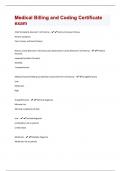Exam 2: NSG22 2/ NSG 22 2 (NEW 2024/ 2025 Update) Family Nursing | Review with Questions and Verified Answers| 100% Correct | Grade d A- Herzing QUESTIONS Hypoglycemia Baby Answer: Hypoglycemia: Temporary low plasma glucose concentrations are common in healthy newborns. Hypoglycemia affects as many as 40% of all full -term newborns. It is defined as a blood glucose level of less than 30 mg/dL or a plasma concentration of less than 45 mg/dL in the first 72 hours of life. Most newborns experience transient hypoglycemia and are asymptomatic. The symptoms, when present, are nonspecific and include jitteriness, lethargy, cyanosis, apnea, seizures, high -
pitched or weak cry, hypothermia, and poor feeding. If hypoglycemia is prolonged or is left untreated, serious, long -term adverse neurologic sequelae such as learning disabilities and intellectual disabilities can occur. Prevent hypoglycemia in newborns at risk by initiating early feedings with breast milk or formula. QUESTIONS Risk Factoris for Hypoglycemia New Born Answer: This period of transition is usually smooth, but certain newborns are at greater risk for hypoglycemia: infants of mothers who have diabetes, preterm newborns, and newborns with intrauterine growth restriction (IUGR), inadequate caloric intake, sepsis, asp hyxia, hypothermia, polycythemia, glycogen storage disorders, and endocrine deficiencies QUESTIONS Treatment of Hypoglycemia Newborn Answer: Treatment of hypoglycemia in the newborn includes administration of a rapid -acting source of glucose such as dextrose gel, breastfeeding or early formula -feeding. In acute, severe cases, intravenous administration of glucose may be required. QUESTIONS How often should breast feeding baby eat Answer: Newborns differ in their feeding needs and preferences, but most breastfed ones need to be fed every 2 to 3 hours, nursing for 10 to 20 minutes on each breast. QUESTIONS Formula Fed New Bords Feed How Often and How to determine if they are eating enough Answer: Formula -fed newborns usually feed every 3 to 4 hours, finishing a bottle in 30 minutes or less. Daily formula intake for an infant should be 1.5 to 2 oz/lb of body weight, but growth is a better measure of health than the amount of formula consumed. If the newborn seems satisfied, wets six to 10 diapers daily, produces several stools a day, sleeps well, and is gaining weight regularly, then he or she is probably receiving sufficient breast milk or formula. QUESTIONS Feeding Newborn Overview Answer: The newborn can be fed at any time during the transition period if assessments are normal and a desire is demonstrated. Before the newborn can be fed, determine his or her ability to suck and swallow. Clear any mucus in the nares or mouth with a bulb syrin ge before initiating feeding. Auscultate bowel sounds, check for abdominal distention, and inspect the anus for patency. If these parameters are within normal limits, newborn feeding may be started. Most newborns are on demand feeding schedules and are all owed to feed when they awaken. When they go home, mothers are encouraged to feed their newborns every 2 to 4 hours during the day and only when the newborn awakens during the night for the first few days after birth. Generally, newborns should be fed on demand whenever they seem hungry. Most newborns will give clues about their hunger status by crying, placing their fingers or fist in their mouth, rooting around, and sucking. QUESTIONS LATCH Score Answer: This assessment is used to help determine if a breast feeding newvorn is feeding appropriately. This assessment helps ensure healthy growth for newborns and prevents nipple integrity of mother QUESTIONS Involution Definition Answer: 6 week progress in which there is contraction of muscle fibers, regreneration of epithelium fibers, and shift of hormones that bring uterus back to pre -pregnancy state QUESTIONS What are used to help with fetal descent during labor and labor pains, several different option s dueing the first stage of labor Answer: Maternal Position Changes QUESTIONS Largely composed of Wharton's Jely and is the life line to the fetus till birth Answer: Umbilican Cord QUESTIONS Baby Blues Answer: Lasts for about 2 weeks after delivery and affects 85% of mothers. QUESTIONS Baby Blue Symptoms Answer: Anxiety, depression, mood swings, irritability, tearfulness, fatigue, and increased sensitivity QUESTIONS Nursing Interventions during First Stage of Labor Answer: Key nursing interventions include: · Identifying the estimated date of birth from the client and the prenatal chart Validating the client's prenatal history to determine fetal risk status Determining fundal height to validate dates and fetal growth Performing Leopold maneuvers to determine fetal position, lie, and presentation Checking FHR Performing a vaginal examination (as appropriate) to evaluate effacement and dilation progress Instructing the client and her partner about monitoring techniques and equipment Assessing fetal response and FHR to contractions and recovery time Interpreting fetal monitoring strips Checking FHR baseline for accelerations, variability, and decelerations Repositioning the client to obtain an optimal FHR pattern Recognizing FHR problems and initiating corrective measures Checking amniotic fluid for meconium staining, odor, and amount Comforting client throughout testing period and labor Documenting times of notification for team members if problems arise Knowing appropriate interventions when abnormal FHR patterns present Supporting the client's decisions regarding intervention or avoidance of intervention Assessing the client's support system and coping status frequently QUESTIONS Assessment During First Stage of Labor





